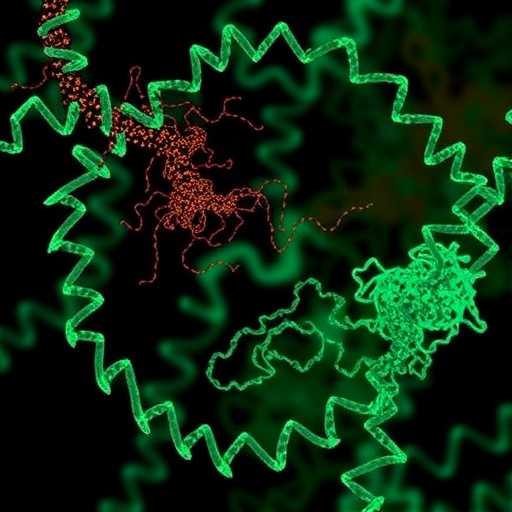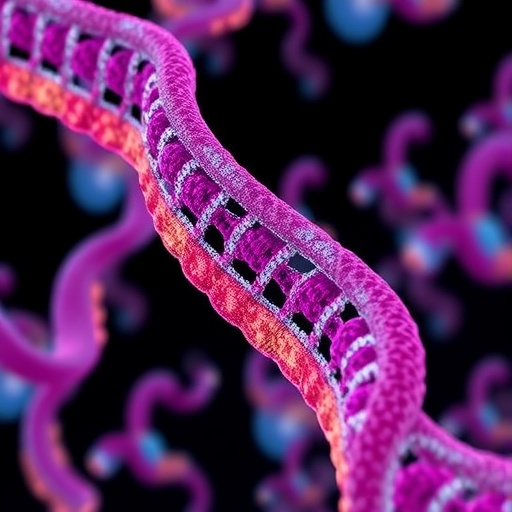
A groundbreaking study has illuminated a previously obscure mechanism behind one of the most devastating neurodegenerative diseases: amyotrophic lateral sclerosis (ALS) and frontotemporal dementia (FTD). Central to this discovery is the notorious hexanucleotide repeat expansion within the C9orf72 gene, a well-known genetic culprit linked to these disorders. Although this mutation has long been implicated in disease pathology through the production of toxic dipeptide repeat proteins (DPRs), the pathway by which an intronic RNA segment accesses the cytoplasmic translation machinery to generate these harmful proteins remained enigmatic until now.
The crux of this new research lies in the revelation that the repeat expansion, previously thought to reside within an intron, is in fact aberrantly retained as part of an extended exon 1 through the employment of alternative splicing mechanisms. This exonization process involves the usage of downstream alternative 5′ splice sites, which effectively hijack the canonical splicing code to splice the intronic repeat expansion into mature mRNA transcripts. This insight overturns longstanding assumptions about how intronic expansions can influence cellular function, revealing a sophisticated layer of RNA processing that directly contributes to disease pathology.
Researchers employed an innovative technique termed “NRE-capture-seq” to selectively isolate and sequence RNAs containing the nucleotide repeat expansion (NRE) from patient-derived fibroblast and neuronal cultures. This powerful approach enabled the precise mapping of splice isoforms harboring the GGGGCC repeats, highlighting the heterogeneity and complexity of the aberrant splicing events. The ability to capture and analyze these rare, pathogenic transcripts in patient cells provides a valuable platform for understanding disease mechanisms at an unprecedented resolution.
.adsslot_qFlkKQ735e{width:728px !important;height:90px !important;}
@media(max-width:1199px){ .adsslot_qFlkKQ735e{width:468px !important;height:60px !important;}
}
@media(max-width:767px){ .adsslot_qFlkKQ735e{width:320px !important;height:50px !important;}
}
ADVERTISEMENT
Analysis of postmortem brain tissue from C9-ALS/FTD patients revealed that these aberrant splice isoforms accumulate in affected tissues. This accumulation underscores the pathological relevance of alternative splicing in driving disease progression. The finding that these extended exon 1 transcripts are not just cellular anomalies but critical contributors to disease expands the scope of therapeutic targets beyond protein aggregates to include the RNA processing machinery itself.
Central to the regulation of this aberrant splicing event is the serine/arginine-rich splicing factor 1 (SRSF1), a well-known RNA binding protein and splicing regulator. The study demonstrates that SRSF1 promotes the inclusion of the repeat expansion into the mRNA transcript by enhancing the usage of the alternative 5′ splice sites. This discovery places SRSF1 as a pivotal regulator of pathogenic RNA biogenesis in C9orf72-linked ALS/FTD, opening avenues for intervention at the level of splicing regulation.
The pathological significance of this mechanism extends beyond RNA processing to the toxic gain-of-function associated with DPR proteins. DPRs, generated through unconventional Repeat-Associated Non-AUG (RAN) translation of the expanded repeat RNA, accumulate in neuronal cytoplasm, exerting proteotoxic stress and contributing to neurodegeneration. By elucidating how the nuclearly retained intronic repeat segment gains access to cytoplasmic translation machinery as part of an extended exon, this study bridges a vital gap in understanding the integration of RNA biology and protein toxicity in ALS/FTD.
Therapeutically, these findings have immediate implications. Targeting SRSF1 with antisense oligonucleotides (ASOs) successfully reduced the abundance of aberrant splice isoforms and consequentially lowered DPR production in patient-derived cells. Similarly, ASOs designed to specifically bind and degrade the NRE-containing splice variants effectively diminished toxic protein levels. This dual-targeting strategy exemplifies precision medicine approaches aimed at rectifying the underlying RNA dysregulation driving disease.
Such advances in antisense technology showcase how manipulating RNA splicing events can translate into tangible therapeutic benefits. The capacity to modulate splicing factors and tailor transcript profiles offers a promising frontier in the treatment of complex neurodegenerative disorders, especially those where traditional protein-centric therapies have faltered. This study is emblematic of the potential held by RNA-centered interventions.
At a molecular level, the study sheds light on the alternative splice sites scattered downstream of the canonical exon 1 boundary. These cryptic 5′ splice sites, normally dormant, become aberrantly activated in the presence of the C9orf72 repeat expansion. This abnormal splice site selection highlights the plasticity of the splicing machinery and how genetic mutations can drastically remodel the transcriptomic landscape in disease conditions.
The notion that an intronic repeat can be exonized via alternative splicing provides a conceptual framework that may apply to other repeat expansion disorders. It suggests that RNA splicing alterations may represent a unifying pathological theme, wherein typically non-coding sequences are co-opted into coding regions, giving rise to new toxic entities. This paradigm shift could recalibrate ongoing research into RNA toxicity across a spectrum of neurodegenerative diseases.
The use of patient-derived neurons and fibroblasts in this research ensures that the observed molecular events reflect biologically relevant contexts, strengthening the translational applicability of the findings. Furthermore, the accumulation of these transcripts in postmortem brain tissues solidifies their pathological relevance in vivo, bridging in vitro mechanistic discoveries with clinical neuropathology.
Beyond the immediate ALS/FTD context, this work expands our understanding of RNA biology’s complexity in human disease. It highlights the intricacies of splicing regulation and how subtle perturbations can have dramatic consequences on cellular homeostasis. The interplay between splicing factors like SRSF1 and aberrant RNA sequences underlines the delicate balance cells must maintain to prevent disease.
The methodology adopted in this work—selective RNA capture combined with deep sequencing—establishes a benchmark for future studies aiming to dissect intricate RNA processing events in disease. It demonstrates how precise molecular tools can unravel the fine details of transcriptomic alterations that were previously inaccessible, paving the way for novel diagnostic and therapeutic strategies.
In summary, this landmark study reveals that aberrant splicing events exonize the C9orf72 hexanucleotide repeat expansion, reconciling how an intronic repeat is converted into a cytoplasmically translated toxic RNA species. By pinpointing SRSF1 as a key modulator and demonstrating that antisense oligonucleotides can effectively suppress pathogenic isoforms and reduce toxic DPR burden, the research sets a new course for therapeutic innovation in ALS/FTD. Such discoveries underscore the growing recognition of RNA processing defects as critical drivers of neurodegeneration and herald a new era of RNA-centric treatment modalities.
These insights not only deepen our comprehension of C9orf72-linked ALS and FTD but also inspire a reevaluation of splicing dysregulation in other repeat-expansion diseases, promising broad implications for neurobiology and medicine. As the field moves forward, strategies that integrate molecular genetics, RNA biology, and targeted therapeutics will likely transform the clinical landscape for patients afflicted with these devastating disorders.
Subject of Research: Aberrant splicing of the C9orf72 hexanucleotide repeat expansion in ALS/FTD and its role in the generation of toxic dipeptide repeat proteins.
Article Title: Aberrant splicing exonizes C9orf72 repeat expansion in ALS/FTD.
Article References:
Yang, S., Wijegunawardana, D., Sheth, U. et al. Aberrant splicing exonizes C9orf72 repeat expansion in ALS/FTD. Nat Neurosci (2025). https://doi.org/10.1038/s41593-025-02039-5
Image Credits: AI Generated
Tags: aberrant splicing in neurodegenerationalternative splicing in ALSamyotrophic lateral sclerosis researchC9orf72 gene repeat expansionfrontotemporal dementia mechanismsgenetic culprits in ALS and FTDintronic RNA segment translationneurodegenerative disease pathologyNRE-capture-seq techniqueRNA processing in neurodegenerative diseasessplicing code hijacking in RNAtoxic dipeptide repeat proteins





